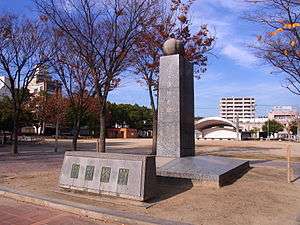Bombing of Okazaki in World War II

The bombing of Okazaki in World War II (岡崎空襲 Okazaki kūshū) was part of the strategic bombing campaign waged by the United States of America against military and civilian targets and population centers during the Japan home islands campaign in the closing states of World War II.[1]
Background
Although the city of Okazaki was not a major population center and had no major targets of military significance, it was a satellite town supporting the metropolis of Nagoya. The Tōkaidō Main Line railway connecting Tokyo with Osaka also ran through the city, and it became one of the 57 regional population centers added to the list of targets by General Curtis LeMay in June 1945 following the destruction of Japan’s main cites.[2]
Air raids
On July 19, 1945, 126 B-29 Superfortress bombers of the USAAF 20th Air Force, 314th Bombardment Wing departed from Guam in the Mariana Islands. On the same day, air raids were also launched against Fukui, Hitachi, and Chōshi.[3] The B-29s arrived over target at Okazaki after midnight on June 20, 1945, and found the target mostly obscured by clouds. Bombing commenced at 0052 hours from an altitude of 3900 meters, and a total of 12,506 Incendiary bombs were dropped on the city, destroying most of the city center. The Okazaki city hall survived the attack; however at 1230 hours, a flight of P-38 Lightning fighters strafed civilians lined up at the city hall awaiting emergency medical treatment. The estimated total civilian casualties were 203 people killed, 13 missing, 32,068 injured with 7312 houses totally destroyed and 230 hours partially destroyed. The bombing rendered about one third of the city’s population homeless. The Imperial Japanese Navy’s Okazaki Air Field, and a large textile plant owned by Nisshinbo Industries were undamaged in the attack, which was aimed solely at the destruction of the city’s civilian population.[4]
A year after the war, the United States Army Air Forces's Strategic Bombing Survey (Pacific War) reported that 32.2 percent of the city had been totally destroyed.[5]
See also
References
- Werrell, Kenneth P (1996). Blankets of Fire. Washington and London: Smithsonian Institution Press. ISBN 1-56098-665-4.
- Bradley, F. J. (1999). No Strategic Targets Left. Contribution of Major Fire Raids Toward Ending WWII. Turner Publishing. ISBN 1-56311-483-6.
- Carter, Kit C (1975). The Army Air Forces in World War II: Combat Chronology, 1941-1945. DIANE Publishing. ISBN 1-4289-1543-5.
- Crane, Conrad C. (1994). The Cigar that brought the Fire Wind: Curtis LeMay and the Strategic Bombing of Japan. JGSDF-U.S. Army Military History Exchange. ASIN B0006PGEIQ.
- Dorr, Robert F. (1994). B-29 Units of World War II. Osprey Publishing. ISBN 1-84176-285-7.
- Frank, Richard B. (2001). Downfall: The End of the Imperial Japanese Empire. Penguin. ISBN 0-14-100146-1.
- Grayling, A. C. (2007). Among the Dead Cities: The History and Moral Legacy of the WWII Bombing of Civilians in Germany and Japan. New York: Walker Publishing Company Inc. ISBN 0-8027-1565-6.
- Hoyt, Edwin P. (2000). Inferno: The Fire Bombing of Japan, March 9 – August 15, 1945. Madison Books. ISBN 1-56833-149-5.
- Shannon, Donald H. (1976). United States air strategy and doctrine as employed in the strategic bombing of Japan. U.S. Air University, Air War College. ASIN B0006WCQ86.
- Wainstock, Dennis (1996). The Decision to Drop the Atomic Bomb. Greenwood Publishing Group. ISBN 0-275-95475-7.
External links
Notes
- ↑ Hoyt. Inferno: The Fire Bombing of Japan, March 9 – August 15, 1945
- ↑ United States Strategic Bombing Survey. Summary Report(Pacific War) July 1, 1946
- ↑ Carter. The Army Air Forces in World War II: Combat Chronology, 1941-1945
- ↑ Bradley. No Strategic Targets Left.
- ↑ Wainstock. The Decision to Drop the Atomic Bomb. Page 9